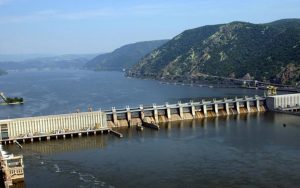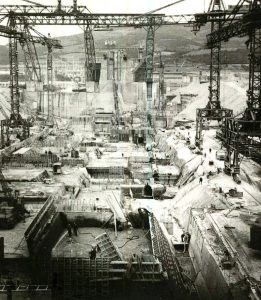Guest Author
This account is reserved for our Guest Authors and Collaborators.
MORE ABOUT THIS AUTHOR
The following text was written by Tijana Rupcic, PhD candidate at the Central European University, and reflects her presentation at our Closing Conference, “Repairing Technology – Fixing Society?” from 13-14 October 2022 in Luxemburg.
The idea of exploiting and regulating the Iron Gates, the last gorge of the Djerdap system on the Danube, originated in the 19th century. The Danube River had become an important travel route, and many European countries took an interest in solving the blockage of the Djerdap gorge. The first initiative to exploit the energy potential of the Djerdap sector of the Danube and improve the waterway was recorded as early as 1896. The favorable characteristics of the Djerdap sector were the high speed of the water and the significant drop, frequent changes in water depth, and bed width. On the other hand, cliffs and underwater rocks represented a constant danger. In 1896, regulatory works on the Djerdap were completed and the Sip Canal was opened. Hugo Luther, the German engineer who led these works, proposed to the Ministry of National Economy of the Kingdom of Serbia that the completion of the regulation of the Djerdap should be used for the construction of an electricity production plant. Although he requested concessions for water power, his request was not granted.[1]

Iron Gates I HPP Locks, 2021.
The question of the Iron Gates was a subject of debate during the Paris Peace Conference when the new state’s borders were being established. Serbian politician Nikola Pašić noted that it “…would be beneficial to utilize the potential of the Danube Iron Gates for the production of electrical energy”.[2] Foreign investors were interested in the area, encouraged by the success of the Rhine-Main-Danube Canal. They were considering the possibility of constructing something like the Danube section in Yugoslavia. Even though this plan was mainly focused on the sailing potential of the Djerdap region, utilization of the electrical potential was also considered. Teams of engineers, geologists, and economists came up with a plan to build two dams with power plants.[3] One would be built on Greben and Donji Milanovac and another on the Sip and Karataš. According to this plan, power plants would significantly accelerate the electrification of the eastern part of the country.[4] However, the plan remained on paper and was not realized because of the global economic crisis.
The possibility of a joint venture between Yugoslavia and Romania to build a hydroelectric power plant at the Iron Gates was revived again after the propaganda war aimed against Yugoslavia following the Tito-Stalin split. Talks were initiated on several occasions after 1955 but work on the project only began in the autumn of 1964. Project Iron Gate I, a hydropower and navigation system, was finalized in May 1972. Each country got an electric plant with an installed capacity of 1050 MW, generating a total of approximately 11 400 million kilowatt hours. Talks on the possibility of building a second plant began during the building of Iron Gate I. However, Yugoslavia showed no interest in financing this kind of project. Finally, Romania agreed to finance the construction of the second hydroelectric power plant, and the Yugoslav part of the plant was built on credit, which was paid back in the form of electric power.[5]

Construction of Iron Gates I, 1970.
It is worth mentioning that already in 1976, there were talks between Yugoslavia and Romania about the possibility of building a third hydroelectric power plant, Iron Gate III, but they went no further than the idea stage because the difficulties in maintaining existing systems were becoming apparent and economic and political changes were beginning to take place.[6]
This paper intends to explore the maintenance of the largest dam on the Danube River and one of the largest hydropower plants in Europe. The designers of Iron Gate I and II did not anticipate any opposition to their original plans. They believed that strict observance of the 50-50 principle would preclude any conflicts or disputes, and thus two different plants with equal capacities were built.
What planners did not foresee was the fact that during periods when the level of the Danube sank dramatically, one side would use a joint reservoir more than anticipated; accidents at one plant would affect the other in ways they did not anticipate, such as damage to turbines by unskilled workers doing repairs; and there were major issues with maintenance of the dam and plants during winter months, when the Danube sank to its lowest levels.
In many ways, the political changes that have occurred in Yugoslavia and Romania from 1972, when Iron Gate I started operating, to this day are reflected in their position on maintenance of the hydro and navigation system of both Iron Gate I and II. Most recently, Serbia and Romania agreed on joint maintenance of the Danube riverbank around the Iron Gates system.

Josip Broz Tito and Nicolae Ceaușescu visiting Iron Gates I, 1972.
The examples mentioned above were points of conflict, and this paper aims to explore how conflicts around maintenance were resolved and how political turmoil affected the repairs and maintenance of such a critical infrastructure site in Europe, from its beginnings to the present day.
[1] Gordana Karović, Miloš Jurišić (2018). Dunav u Srbiji. Putovanje kroz Tehničke muzeje: Katalog izložbe. Belgrade: Muzej nauke i tehnike
[2] Bogdan Križman and Bogumil Hrbak. Zapisnici sa sednica delegacije Kraljevine SHS na Mirovnoj konferenciji u Parizu 1919-1920. [Proceedings from the sessions of the delegation of the Kingdom of Serbs, Croats and Slovenes at the Peace Conference in Paris 1919-1920], Belgrade: Institut društvenih nauka, 1960: 265.
[3] Sergije Maksimov. Rad na studiji o generalnom uređenju dunavskog sektora zvanog “Đerdap.” Plovidba i iskorišćavanje vodene snage. Rezime. Ministarstvo poljoprivrede i voda, Generalna direkcija voda, Đerdapska sekcija, Belgrade, 1928: 11, 23.
[4] Arhiv Jugoslavije [Archives of Yugoslavia], F. 334 Ministry of the Foreign Affairs, 334-654-1928, 2273, 3222; 334-655-1929, 3741, 4766. See also: F. 369 Delegation of the Kingdom of Yugoslavia in the International Danube Commission, 369-26/II, 259/27.
[5] https://www.eps.rs/lat/djerdap/Stranice/istorija.aspx, last accessed on September 24th, 2022
[6] https://www.eps.rs/lat/djerdap/Stranice/istorija.aspx, last accessed on September 24th, 2022